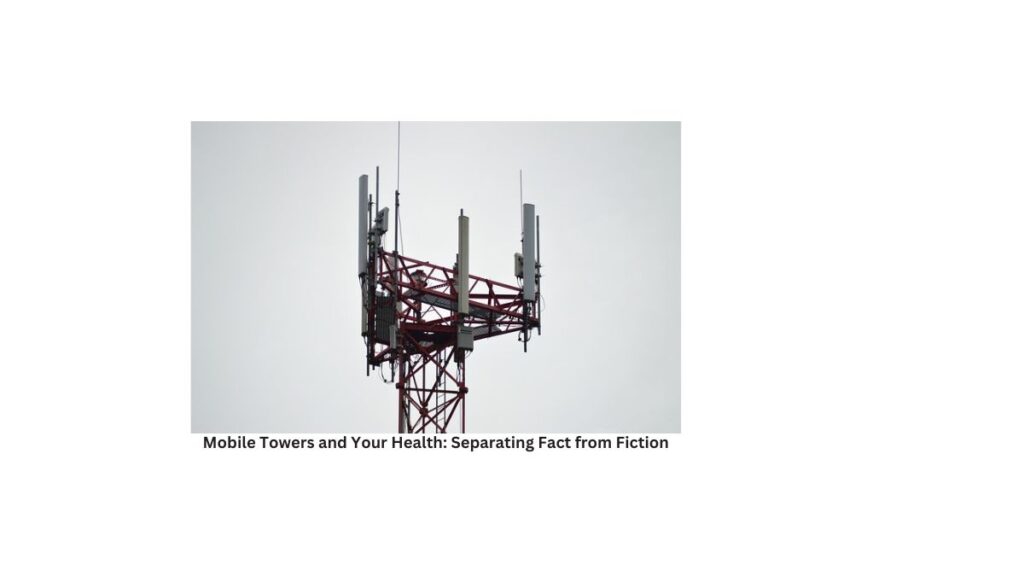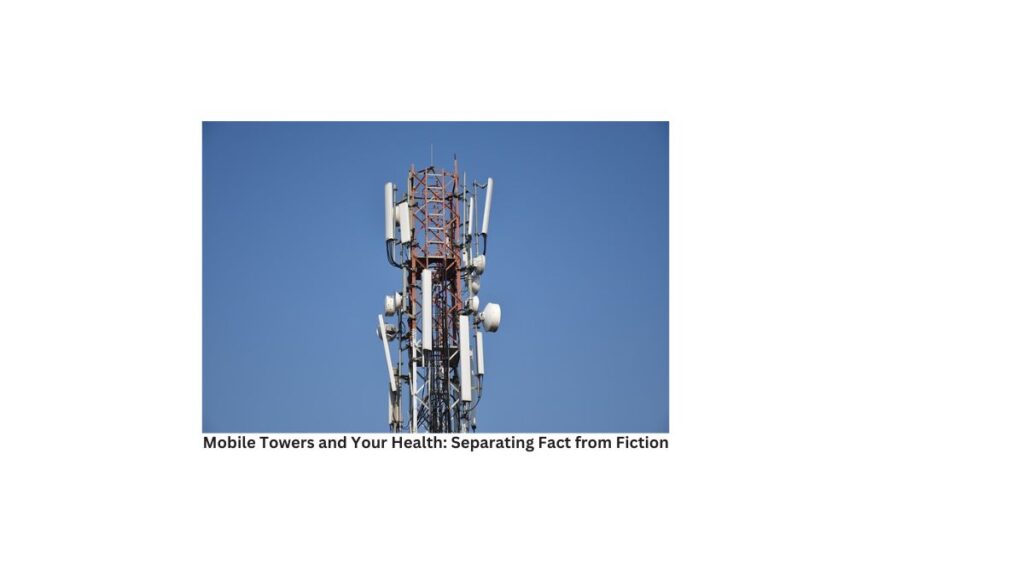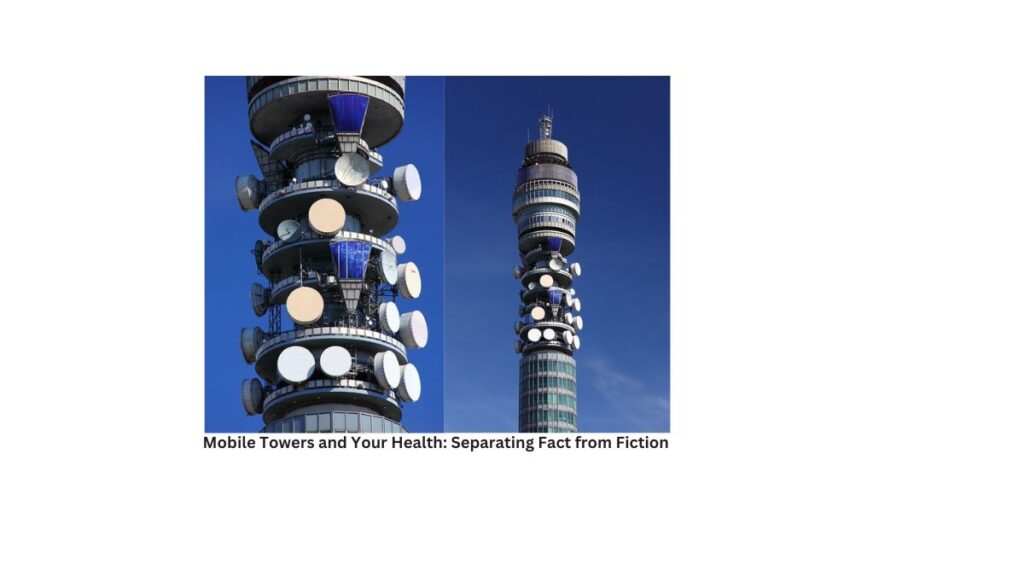Introduction:-
Mobile Towers and Your Health: Separating Fact from Fiction
In the age of connectivity, mobile towers have become ubiquitous, facilitating our constant need for communication. However, concerns about the potential health effects of radiation emitted by these towers have sparked debates and raised questions. In this article, we’ll delve into the facts and dispel the myths surrounding mobile towers and their impact on health.
Understanding Mobile Towers Radiation

Before diving into the discussion, it’s essential to understand the type of radiation emitted by mobile towers. Mobile towers primarily emit non-ionizing radiation, which differs from the ionizing radiation associated with X-rays and nuclear sources. Non-ionizing radiation, such as that from mobile towers, lacks the energy to alter DNA or cause cellular damage in the same way ionizing radiation does.
Debunking Common Myths
- Myth: Mobile tower radiation causes cancer. While concerns about cancer risk have circulated, extensive research conducted by reputable organizations, including the World Health Organization (WHO) and the International Agency for Research on Cancer (IARC), has found no conclusive evidence linking mobile tower radiation to cancer in humans.
- Myth: Living near a mobile tower poses significant health risks. Despite anecdotal claims, numerous scientific studies have failed to establish a causal relationship between proximity to mobile towers and adverse health effects. Regulatory agencies, such as the Federal Communications Commission (FCC) in the United States, have set exposure limits well below the levels known to cause harm.
- Myth: Radiation from mobile towers is the same as radiation from nuclear sources. This misconception often stems from a lack of understanding about the different types of radiation. Non-ionizing radiation emitted by mobile towers is fundamentally different from the ionizing radiation produced by nuclear sources, which has far greater energy and potential for harm.
Mitigating Risks and Ensuring Safety
While scientific evidence suggests that mobile tower radiation poses minimal risk to human health, it’s natural to want to take precautions. Here are some practical steps individuals can take:
- Maintain Distance: Although research indicates that exposure levels from mobile towers are typically well below safety limits, maintaining a reasonable distance from towers whenever possible can further reduce exposure.
- Use Technology Wisely: Limiting excessive use of mobile devices can help minimize overall exposure to radiation. When making calls, consider using hands-free options or texting instead.
- Stay Informed: Stay updated on the latest research and guidelines from reputable sources such as the WHO, FCC, and other regulatory bodies. Understanding the science behind mobile tower radiation can help alleviate concerns and make informed decisions.
How far should you live from a mobile tower to be safe?
Determining a specific distance from a mobile tower to guarantee safety is challenging because various factors affect the level of radiation exposure. However, regulatory bodies such as the Federal Communications Commission (FCC) in the United States have established safety standards and exposure limits well below levels known to cause harm.

Generally, the radiation exposure from mobile towers decreases rapidly with distance from the tower. As a rule of thumb, maintaining a reasonable distance from the tower can help reduce exposure levels further.
While there isn’t a universally agreed-upon “safe distance,” experts often suggest that living several hundred meters away from a mobile tower can significantly reduce exposure levels. However, it’s important to note that even individuals living very close to mobile towers typically experience exposure levels well within safety limits set by regulatory agencies.
Ultimately, the decision of how far to live from a mobile tower involves weighing various factors, including personal preferences, local regulations, and the availability of alternative housing options. It’s advisable to stay informed about the latest research and guidelines from reputable sources to make an informed decision about proximity to mobile towers.
How to check mobile towers radiation?
Checking mobile tower radiation levels typically requires specialized equipment, such as electromagnetic field (EMF) meters or radiation detectors. Here’s a general guide on how to check mobile tower radiation:

- Research Regulations: Familiarize yourself with local regulations regarding mobile tower radiation levels and permissible exposure limits. Regulatory agencies such as the Federal Communications Commission (FCC) in the United States provide guidelines for acceptable radiation levels.
- Obtain Equipment: Acquire an EMF meter or radiation detector capable of measuring electromagnetic radiation in the frequency range used by mobile towers. These meters are available for purchase online or from specialized retailers.
- Choose Measurement Location: Select the location where you want to measure radiation levels. This could be indoors or outdoors, depending on your concerns and the proximity of mobile towers to your residence or workplace.
- Calibrate the Meter: Follow the manufacturer’s instructions to calibrate the EMF meter or radiation detector properly before taking measurements. Calibration ensures accurate readings.
- Take Measurements: Hold the EMF meter or radiation detector at the desired location and observe the readings displayed on the device. Move the meter around to assess radiation levels from different directions if necessary.
- Interpret Results: Compare the measured radiation levels to applicable safety standards or exposure limits established by regulatory agencies. Ensure that the readings are within acceptable ranges.
- Consult Experts: If you’re unsure about interpreting the results or concerned about the findings, consider consulting with experts in radiation safety or environmental health. They can provide guidance and advice based on their expertise.
- Take Precautionary Measures: Based on the measurements and expert recommendations, you may decide to take precautionary measures to minimize radiation exposure, such as relocating sensitive equipment or adjusting the layout of living or working spaces.
- Regular Monitoring: Consider periodically monitoring radiation levels to track any changes over time, especially if new mobile towers are installed in the vicinity or if there are alterations to existing infrastructure.
It’s important to note that while measuring mobile tower radiation levels can provide valuable information, it’s just one aspect of assessing potential health risks. Consulting with experts and staying informed about the latest research can help you make well-informed decisions regarding radiation exposure.
Conclusion
In conclusion, separating fact from fiction is crucial when evaluating the potential health effects of mobile tower radiation. While concerns exist, the overwhelming body of scientific evidence indicates that the risks associated with mobile tower radiation are minimal, especially when compared to other common exposures in our environment. By staying informed and relying on reputable sources, individuals can make informed decisions to ensure their well-being in an increasingly connected world.





